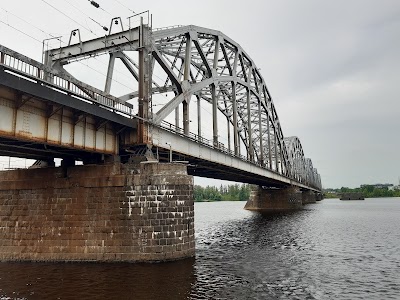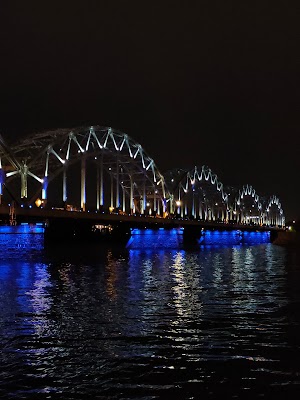Riga - Jelgava Railway Bridge (Rīgas - Jelgavas dzelzceļa tilts)
Overview
Riga - Jelgava Railway Bridge: A Marvel of Engineering
Nestled within the picturesque landscapes of Ozolnieki Municipality, the Riga - Jelgava Railway Bridge (Rīgas - Jelgavas dzelzceļa tilts) is not just a vital transport link; it is an iconic landmark that embodies both the historical significance and architectural prowess of Latvia. Spanning the beautiful Lielupe River, this bridge serves as a crucial connection between the capital city, Riga, and the historic town of Jelgava. Its strategic importance is accentuated by the fact that it was designed to facilitate both passenger and freight traffic, showcasing Latvia’s commitment to modernizing its infrastructure while honoring its rich heritage.
Constructed in the late 19th century, the bridge has undergone various renovations and upgrades to maintain its functionality and safety. Visitors will appreciate its elegant design, characterized by steel girders and strong arches that evoke a sense of grandeur. As you stand on the bridge, you will be treated to breathtaking views of the surrounding countryside and the serene flow of the Lielupe River below. The area is particularly enchanting during the late afternoon golden hour, when the sunlight casts a warm glow over the bridge and the river, creating a picturesque scene perfect for photography enthusiasts.
Historical Context and Cultural Significance
The Riga - Jelgava Railway Bridge is not merely a functional structure; it also carries a rich tapestry of history. Opened in 1876, it was a significant development during the burgeoning industrial era in Latvia. The bridge played a vital role in enhancing trade and travel, allowing goods and people to move more freely between regions. This contributed to the economic growth of both Riga and Jelgava, helping them evolve into important urban centers.
Beyond its practical purposes, the bridge serves as a symbol of resilience and progress for the Latvian people. Over the decades, it has witnessed significant historical events, including the struggles for independence and the changing political landscapes of the region. Today, it stands as a testament to Latvia's journey through time, offering visitors a glimpse into the country's past while embodying its aspirations for the future.
Visiting the Bridge
For travelers venturing into Ozolnieki Municipality, the Riga - Jelgava Railway Bridge is a must-visit attraction. Aside from the stunning views from the bridge itself, the surrounding area offers a plethora of outdoor activities. The Lielupe River provides opportunities for kayaking, fishing, and leisurely hiking along its banks. There are also several picnic spots nearby, perfect for those looking to enjoy a peaceful day in nature.
If you’re interested in further exploration, consider visiting the nearby town of Jelgava. This charming town is steeped in history, featuring the beautiful Jelgava Palace and the stunning St. Anna’s Church. The blend of historical architecture and lush parks creates a delightful atmosphere, making it an ideal complement to your visit to the bridge.
In summary, the Riga - Jelgava Railway Bridge is more than just a transportation route; it is a significant piece of Latvia’s cultural and historical landscape. It invites travelers to pause, reflect, and appreciate the beauty of engineering and the stories of the past. Whether you are an architecture enthusiast, a history buff, or simply a curious traveler, this landmark is sure to enrich your experience in Latvia.




